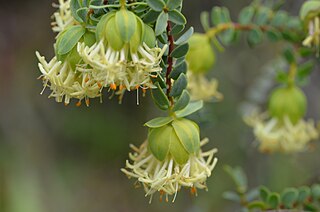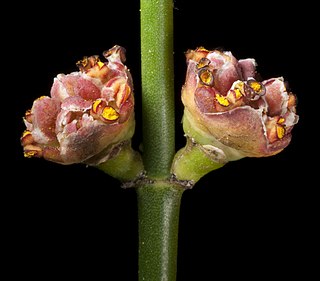
Tasmannia stipitata, commonly known as the Dorrigo pepper or northern pepperbush is a rainforest shrub of temperate forests of the Northern Tablelands of New South Wales, Australia. Leaves are fragrant, narrow-lanceolate to narrow-elliptic, 8–13 cm long. Dark bluish to mauve berries follow the flowers on female shrubs. The species is dioecious, with male and female flowers on separate plants.

Ficus fraseri, the white sandpaper fig or shiny sandpaper fig, is one of several fig species commonly known as sandpaper figs. It is native to New South Wales, Queensland and the Northern Territory in Australia and to New Caledonia and Vanuatu. Other common names are "figwood" and "watery fig".

Gyrostemon is a genus of shrubs or small trees in the family Gyrostemonaceae, endemic to Australia.

Stypandra glauca is a species of rhizomatous perennial plant. It is widespread across southern areas of Australia, where it is informally known as the nodding blue lily or blind grass.

Grevillea ramosissima, commonly known as fan grevillea, is a shrub species of the family Proteaceae. It is native to south-eastern Australia.

Ammannia multiflora, commonly known as many-flower ammannia and jerry-jerry in Victoria, is a species in the family Lythraceae. It is widespread in Asia, tropical and sub-tropical Africa and Australia. It can be found in shallow water and damp heavy soils.
Haegiela is a genus of flowering plants in the daisy family described as a genus in 1990. There is only one known species, Haegiela tatei, native to South Australia, and Victoria.

Seringia integrifolia is a shrub of the family Malvaceae native to inland Australia in New South Wales, South Australia, Western Australia, Queensland, and the Northern Territory.

Cuscuta australis, commonly known as Australian dodder, is a herb in the family Convolvulaceae.
The Australasian Virtual Herbarium (AVH) is an online resource that allows access to plant specimen data held by various Australian and New Zealand herbaria. It is part of the Atlas of Living Australia (ALA), and was formed by the amalgamation of Australia's Virtual Herbarium and NZ Virtual Herbarium. As of 12 August 2014, more than five million specimens of the 8 million and upwards specimens available from participating institutions have been databased.

Amyema maidenii is a species of flowering plant within the genus Amyema, an epiphytic hemiparasitic plant of the family Loranthaceae native to Australia and found Australia-wide in the inland.

Atriplex fissivalvis, commonly known as gibber saltbush, is a plant species in the family Amaranthaceae, subfamily, Chenopodioideae. It occurs in the Australian states of South Australia, New South Wales, Queensland and the Northern Territory.

Pimelea sulphurea is a plant in the Thymelaeaceae family.

Ptilotus schwartzii is a grass-like plant in the Amaranthaceae family.

Ptilotus divaricatus is a grass-like plant in the Amaranthaceae family.

Poa drummondiana is a perennial herb in the Poaceae family.

Calycopeplus paucifolius is an erect shrub species in the family Euphorbiaceae. It is found in South Australia & Western Australia.

Styphelia coelophylla is a plant in the family Ericaceae native to Western Australia. It was first described as Leucopogon coelophyllus in 1839 by Allan Cunningham, but based on the phylogenetic studies of Darren Crayn, Michael Hislop and Caroline Puente-Lelièvre in 2020 it was moved to the genus, Styphelia.

Tribulus occidentalis, common name perennial caltrop, is a species of flowering plant in the family Zygophyllaceae, which is native to Australia, and found in Western Australia, Queensland, South Australia and the Northern Territory.

Gyrostemon racemiger is a plant in the family, Gyrostemonaceae. It was first described in 1909 by Hans Paul Heinrich Walter.



















